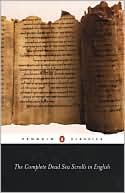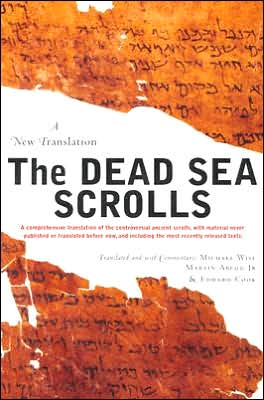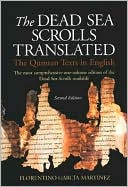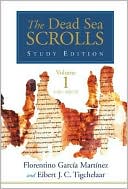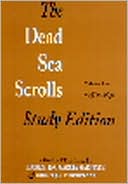The Dead Sea Scrolls Bible: The Oldest Known Bible Translated for the First Time into English
From the dramatic find in the caves of Qumran, the world's most ancient version of the Bible allows us to read the scriptures as they were in the time of Jesus. Review “All those who want to know what the Bible really says will want this book. They will sing, ‘Hallelujah!’” -- Southwestern Journal of Theology About the Author Martin Abegg Jr. is co-director of the Dead Sea Scrolls Institute at Trinity Western University in British Columbia. He is one of the...
Search in google:
Three eminent Biblical scholars have translated previously unpublished Biblical manuscripts for inclusion into this book which contains all 220 of the Dead Sea Scrolls, with hundreds of new and different readings from the Old Testament. While largely confirming texts that have been in use for 2,000 years, the Scrolls also contain a number of differences in wording that clarify puzzles, restore lost Psalms, reveal details of biblical characters' lives, and offer new readings on how the Hebrew Bible was developed. Includes clear, concise commentary. Southwestern Journal of Theology “All those who want to know what the Bible really says will want this book. They will sing, ‘Hallelujah!’”
IntroductionAt the time of Jesus and rabbi Hillel — the origins of Christianity and rabbinic Judaism — there was, and there was not, a "Bible." This critical period, and the nature of the Bible in that period, have been freshly illuminated by the biblical Dead Sea Scrolls.There was a Bible in the sense that there were certain sacred books widely recognized by Jews as foundational to their religion and supremely authoritative for religious practice. There was not, however, a Bible in the sense that the leaders of the general Jewish community had specifically considered, debated, and definitively decided the full range of which books were supremely and permanently authoritative and which ones — no matter how sublime, useful, or beloved — were not. The collection or collections of the Scriptures varied from group to group and from time to time. All Jews would have recognized "the Law" (the Torah) and most would have recognized "the Prophets" as belonging to that collection. Such a recognition is attested by references in the New Testament to the "Law and the Prophets" (Matt 7:12; Luke 16:16; and Rom 3:21). But the exact contents of "the Prophets" may not have been the same for all, and the status of other books beyond "the Law and the Prophets" was neither clear nor widely accepted. The notion of a wider collection of Scriptures that extended beyond the Law and Prophets is suggested by an intriguing passage in Luke 24, which says that "everything written about me [i.e., Jesus] in the Law of Moses, in the Prophets, and in the Psalms must be fulfilled" (vs. 44).The Dead Sea Scrolls help us see the state of affairs more clearly from an on-the-spot perspective. "The Bible," or more accurately then, "the Scriptures," would have been a collection of numerous separate scrolls, each containing usually only one or two books. There is indeed persuasive evidence that certainbooks were considered "Scripture." But there is little evidence that people wereseriously asking the question yet about the extent or the limits of the collection — the crucial question for a "Bible" or "canon" — which books are in and which books are outside this most sacred collection.Thus, The Dead Sea Scrolls Scriptures may be a more historically accurate title for this volume. At any rate, it presents the remains of the books for which there is good evidence that Jews at that time viewed them as Sacred Scripture. The "Bibles" Used TodayThe word "Bible" has different meanings for different people and groups. The most obvious difference in content is between the Bible of Judaism (i.e., the Hebrew Bible or Old Testament) and that of Christianity, which contains both the Old and New Testaments. The Dead Sea Scrolls Bible does not include any New Testament books for one simple reason: by the time the vast majority of the scrolls had been copied (in 68 CE), the New Testament was only beginning to be written. Not surprisingly, then, there are no copies of New Testament books among the scrolls.The list of books included in a Bible is termed a "canon." There are three main canons in the different Bibles used today (see Figure 1):1. The Jewish Bible (or Tanak) contains twenty-four books in three sections: the Torah, the Prophets, and the Writings.2. The Protestant Old Testament contains the same books as the Tanak, but in four sections and in a different order: the Pentateuch, the Historical Books, the Poetical Books, and the Prophets. In addition, the Protestant canon contains thirty-nine books, not twenty-four, because it counts separately several books that comprise single books in the Jewish Bible. For example, the one Book of the Twelve Minor Prophets in the Jewish canon becomes the twelve books of the Minor Prophets in the Protestant Bible.3. The Roman Catholic Old Testament contains exactly the same four divisions and thirty-nine books as the Protestant Bible, but also includes further writings. Seven of these are entire books (Tobit, Judith, 1 and 2 Maccabees, Wisdom of Solomon, Ecclesiasticus, and Baruch [which includes the Letter of Jeremiah]); the others are sections added to Esther (the Additions to Esther) and to Daniel (the Prayer of Azariah, Song of the Three Young Men, Susanna, and Bel and the Dragon). For Catholics, these additional writings are part of the Bible and are thus known as the "deuterocanonical books" (that is, a second group of canonical books). However, Jews and most Protestants do not view these writings as Scripture, labeling them the "Apocrypha" (plural of "Apocryphon"), which means "hidden books."Some scholars believe that these books are not in the Jewish and Protestant canons because they are later than most other biblical books (Daniel being an exception), while others point to their supposed secular or unorthodox content as the reason for exclusion. The real explanation, however, is more complicated and goes back to two ancient Bibles. Early Christians accepted the Greek Septuagint, which contains these additional books, as their Old Testament, while early Rabbis finalized the list of books for the Hebrew Bible in the second century CE. It is these two early collections (the shorter Hebrew one and the longer Greek one) that determine which books are included in the Bibles used by modern Jews, Protestants, and Catholics. Jews, followed by Protestants, regard the shorter collection as Scripture, whereas Catholics accept a larger canon that includes apocryphal/deuterocanonical writings found in the Septuagint.Three Old BiblesAll modern Bibles are translations of older texts. The Scriptures used by most readers of this book (whether Jewish, Protestant, or Roman Catholic) are based on much older manuscripts that have been translated into English. The three most important of these older Bibles are known as the "Masoretic Text" (MT), the "Septuagint" (LXX), and the "Samaritan Pentateuch" (SP). Scholars believe that the books in these three texts are from pre-Christian times, but unfortunately no really early manuscripts were available before the discovery of...
IntroductionHow to Read This BookTorah1Genesis3Exodus23Leviticus77Numbers108Deuteronomy145Jubilees196Prophets199Joshua201Judges208Samuel213Kings260Isaiah267Jeremiah382Ezekiel407The Book of the Twelve Minor Prophets417Hosea419Joel428Amos433Obadiah441Jonah443Micah447Nahum455Habakkuk459Zephaniah463Haggai467Zechariah470Malachi4761 Enoch480Daniel482Other Books503Psalms505Job590Proverbs594Ben Sira (Sirach)597Ruth607The Song of Songs (Canticles)611Qohelet (Ecclesiastes)619Lamentations622The Epistle of Jeremiah628Esther630Chronicles632Ezra-Nehemiah634Tobit636Bibliography647
\ Southwestern Journal of Theology"All those who want to know what the Bible really says will want this book. They will sing, ‘Hallelujah!’"\ \ \ \ \ Southwestern Journal of Theology“All those who want to know what the Bible really says will want this book. They will sing, ‘Hallelujah!’”\ \

